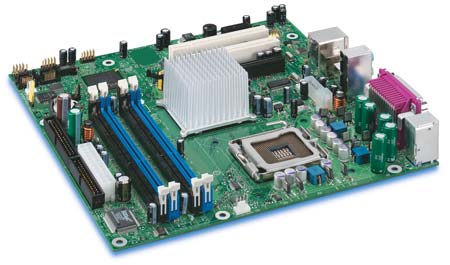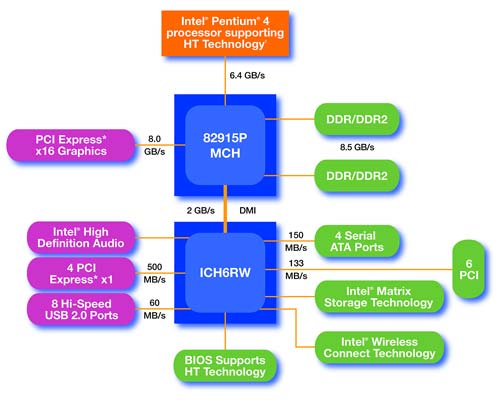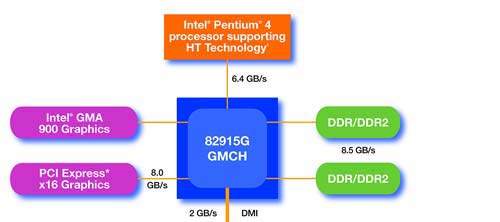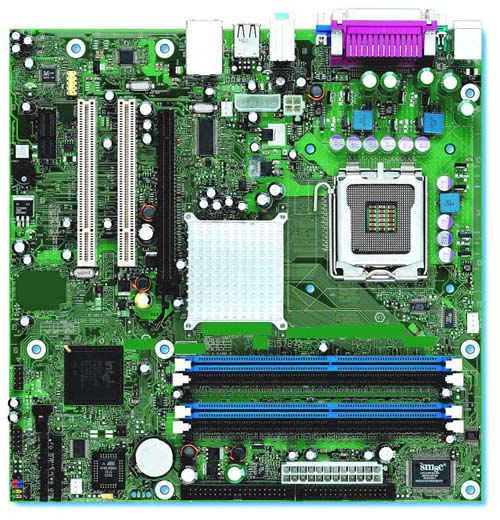Intel 925X/915: Chipset Performance & DDR2
by Wesley Fink on June 19, 2004 3:01 AM EST- Posted in
- CPUs
Intel 915G Express
Intel also provided a D915GUX motherboard for evaluation.
The 915 chipset comes in several flavors, both with and without the new Intel integrated graphics.

Most mainstream boards geared to AnandTech readers will feature the 915p chipset, without integrated graphics. The chipset is essentially a 925X without the acceleration technology, but with the added option of using either DDR or DDR2 memory, depending on what memory support the manufacturer chooses to provide. Other options are provided by the Southbridge and depend on which ICH6 version is paired with the 915P.

915G offers the same options as 915P, but adds Intel's integrated graphics. Intel has significantly upgraded integrated graphics for the 915 chipset, and now support DirectX 9 and OpenGL 1.4 on their integrated graphics. The new solution is called "Intel Graphics Media Accelerator 900". Intel claims that performance is doubled over Intel Intense Graphics 2. AnandTech takes a closer look at the performance of the new Intel integrated Graphics in the review of the Socket 775 CPU launch and PCIe Graphics that is the companion to this article. There is also an economy version of the 915 called 915GV, with integrated Media Accelerator 900 graphics, but without a PCIe 16X graphics card slot. We suspect that the 915GV will become a favorite of the Corporate desktop.

The D915GUX that we evaluated had all of the 915 features in a micro ATX form factor. Despite the smaller size, the D915GUX still provides integrated graphics, plus a PCIe 16X graphics slot, a PCIe 1X slot, and 2 PCI slots. All of the Intel boards, even the 915gux, provide 4 DIMM slots and support up to 4GB of memory. Please also notice that a 24-pin power connector, and not a 20-pin, is also a feature of 915 boards. 20-pin is backwards compatible, however, and the 24-pin is keyed to accept a standard 20-pin connector on one side of the new 24-pin.










57 Comments
View All Comments
Wesley Fink - Saturday, June 19, 2004 - link
#22 & #23 - This will all make more sense when Derek's companion piece is posted later today, which compares the 3.6, 3.4EE, and AMD chipsets.There is no 3.6EE, and we considered comparing the 3.4EE, but the early benches showed the 3.6 to be a fairer comparison. The 3.6 is the only new Intel chip and the top (3.4EE is just a new 775 package launch) and the FX53 is the top AMD chip. The FX53 runs at the same speed as the 3800+ (2.4GHz) but has twice the cache, and both are Dual-Channel Socket 939. The FX55 will not be released until late this year.
Comparing last year's 3200+, the first Socket 754 Athlon 64 and single-channel, to the just-released 560 (3.6GHz) compares nothing.
Bozo Galora - Saturday, June 19, 2004 - link
If the chipset supports only one IDE channel, why does the Gigabyte board have two green IDE sockets.Am I missing something?
I really wanna know, because only one IDE means I dont buy this stuff.
shabby - Saturday, June 19, 2004 - link
So when are the dual core cpu's coming out? Think ill wait for those.SDA - Saturday, June 19, 2004 - link
That's just it, though, the FX-53 is just a few tens of dollars more than the 3800+, so some people figure why not? AMD is overcharging because they know they can get away with it..stephenbrooks - Saturday, June 19, 2004 - link
Maybe replace '3500+' by '3800+' above.stephenbrooks - Saturday, June 19, 2004 - link
One interesting thing is the difference it makes which AMD chip people compare the 3.6E to in these reviews. Before coming here I read the one at http://www.bit-tech.net/review/326/ and came away thoroughly impressed. The clincher was that they compared to the A64 3200+ whereas this review compared to the FX-53.I'm not totally sure if the 3.6E _should_ be compared to the FX-53, being as it is marketed as a '560', in the 5xx 'mid-range' desktop segment for Intel. A better comparison for the high-price-end might be 3.4/3.46EE vs. FX-53 or '720' vs. FX-55 later on.
I'd think 3.6E vs. A64 3700+, or even better the 3500+ (as it's on AMD's new socket too) would be an informative comparison. It's just a shame Intel's high-end offerings are a bit thin on the ground right now.
Staples - Saturday, June 19, 2004 - link
Good review. I wish you had compared the 875 with the 925x however both using a Presscott CPU. With one using a Northwood and one using a Presscott fails to show which chipset optimizes the power of the CPU. The fact that you didn't further inphasises that Intel is in one hellava drought. The 3.2 Northwood/875 combo that came out like 8+ months ago is still faster than ANYTHING they have released.I am waiting for a reason to upgrade but this sure isn't something I was looking for. With Intel having these troubles, AMD is going to take their sweet time putting out anything faster.
Pumpkinierre - Saturday, June 19, 2004 - link
It would be great to see the 915 with Skt478- best of both worlds. I know that Skt775 is appearing on 865 mobos (Abit AS8). At that last Taiwan computer expo they had dual intel Sckt mobos but were they 915s?rjm55 - Saturday, June 19, 2004 - link
#16 - I disagree with you. I think Northwood on 875 is exactly the right comparison to Prescott 775 on 925X. Both at the same speed as done in the review. Prescott was not designed for 875, so comparing the best last generation 875/Northwood to the new 925X/Prescott is extremely fair. I'm sure Intel would have preferred a comparison of Prescott to Prescott, because they would have looked better. I think that was #4's point, which you apparently missed.Doormat - Saturday, June 19, 2004 - link
Now I dont feel so bad about buying that P4-3.0C/i875 combo last month...